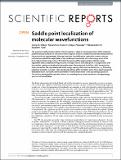Saddle point localization of molecular wavefunctions
Author(s)
Mellau, Georg Ch.; Kyuberis, Alexandra A.; Polyansky, Oleg L.; Zobov, Nikolai; Field, Robert W
Downloadsrep33068.pdf (2.364Mb)
PUBLISHER_CC
Publisher with Creative Commons License
Creative Commons Attribution
Terms of use
Metadata
Show full item recordAbstract
The quantum mechanical description of isomerization is based on bound eigenstates of the molecular potential energy surface. For the near-minimum regions there is a textbook-based relationship between the potential and eigenenergies. Here we show how the saddle point region that connects the two minima is encoded in the eigenstates of the model quartic potential and in the energy levels of the [H, C, N] potential energy surface. We model the spacing of the eigenenergies with the energy dependent classical oscillation frequency decreasing to zero at the saddle point. The eigenstates with the smallest spacing are localized at the saddle point. The analysis of the HCN HNC isomerization states shows that the eigenstates with small energy spacing relative to the effective (v 1 , v 3 , l) bending potentials are highly localized in the bending coordinate at the transition state. These spectroscopically detectable states represent a chemical marker of the transition state in the eigenenergy spectrum. The method developed here provides a basis for modeling characteristic patterns in the eigenenergy spectrum of bound states.
Date issued
2016-09Department
Massachusetts Institute of Technology. Department of ChemistryJournal
Scientific Reports
Publisher
Nature Publishing Group
Citation
Mellau, Georg Ch. et al. “Saddle Point Localization of Molecular Wavefunctions.” Scientific Reports 6, 1 (September 2016): 33068 © 2016 The Author(s)
ISSN
2045-2322